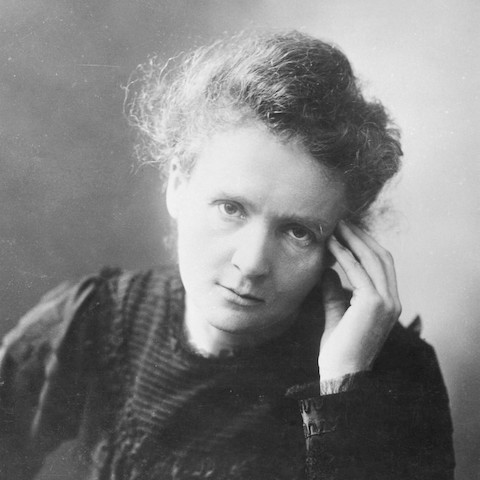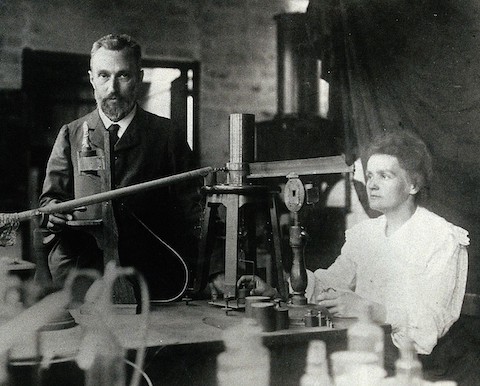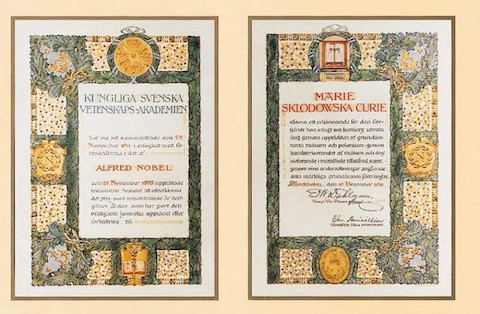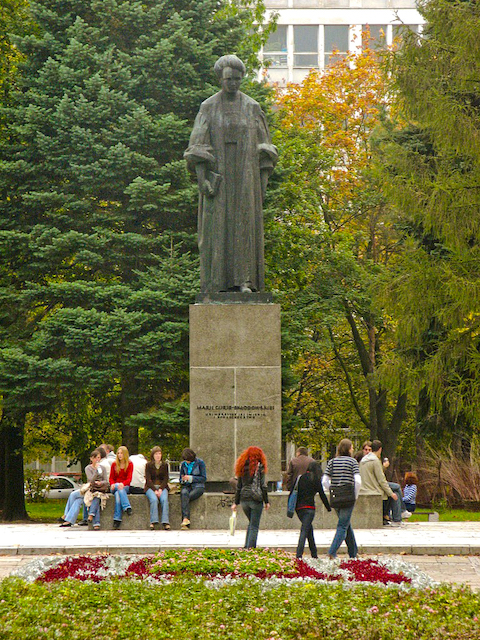
Credit: Tekniska museet, via Wikimedia Commons
In 1891, Manya Skłodowska moved from Warsaw to Paris to study at the Sorbonne.
In just three years, she earned two degrees, in physics and mathematics—then took a job with a promising young scientist.
They fell in love and were married. She changed her Polish first name to the French version: Marie. And took his last name: Curie.
Marie and Pierre Curie became the first to understand and measure radioactivity, then the first to identify the element radium.
When he was killed in an accident, she was devasted, but pushed on. She established the world’s first radiation lab at the Sorbonne, then another to research and treat cancer. And she trained a new partner: her 17-year-old daughter Irène.
During World War I, mother and daughter developed portable X-ray machines to locate shrapnel and fractures in injured soldiers, operated them on the battlefield, and trained medics to use them.
Marie never patented her work or sought to profit from it. She just wanted to do the science and share it with the world. But that doesn’t mean she wasn’t rewarded.
She was the first woman to win a Nobel Prize, for physics, at just 36.
Then the first person to win a second Nobel Prize, this time in chemistry.
That made her the only person ever to win Nobel Prizes in two different sciences.
If that’s not enough, her daughter eventually won one, too.
Marie and Irène Curie: trailblazing women on the forefront of science.
Background
Synopsis: Marie Curie was the first woman to win a Nobel Prize and the first individual to win two Nobel Prizes. In 1903, she won the prize in physics for studies of radioactivity with her husband Pierre and Henri Becquerel, and in 1911, she won the prize in chemistry for the isolation of polonium and radium. Marie Curie remains the only individual to have won the Nobel Prize in two different sciences. She pioneered the study of tumors and treatments for cancer, founding the Curie Institutes in Paris and Warsaw. She died in 1934 of radiation-related illness, leaving behind a remarkable legacy of science discovery as well as broken gender barriers.
- Manya Skłodowska was the youngest of five children born to schoolteachers in Warsaw, Poland on November 7, 1867. Her mother died of tuberculosis when she was 10.
- Manya had an insatiable appetite for learning and attended a secret school called the “Floating University” in Russian-occupied Poland.
- She became a governess to earn enough money to move with her older sister to Paris in 1891. Once there, Manya attended the Sorbonne, earning a degree in physics in 1893 and in mathematics in 1894.
- In 1894, she took a job in the lab of Pierre Curie in Paris. When she married him a year later, she changed the spelling of her first name to its French version—Marie.
- Marie and Pierre began pioneering work on the mysterious radiation given off by uranium, which Henri Becquerel had recently discovered. Their laboratory was little more than a shack.
- Marie correctly hypothesized that the mysterious high-energy emissions were a basic property of uranium’s atoms, suggesting atoms might not be stable.
- She noticed that samples of pitchblende (now called uraninite) gave off more radiation than pure uranium, so Marie suspected that one or more unknown elements were contributing to the high readings. Other scientists were skeptical.
- She and Pierre worked to separate the different elements in pitchblende, extracting a black powder 330 times as radioactive as uranium. It was named polonium and had the atomic number 84.
- After extracting the polonium, the remaining liquid was still very radioactive, so the Curies deduced that another, even more radioactive element must exist.
- In 1898, they published strong supporting evidence of the element with atomic number 88, naming it radium.
- Because radium occurred in trace amounts, Marie purchased tons of inexpensive waste material from the processing of Bavarian pitchblende and proceeded to process 45-lb (20 kg) batches by grinding, dissolving, filtering, precipitating, crystallizing, and recrystallizing the material to concentrate its radium for study.
- In 1902, Marie finally isolated radium chloride, but the four years of physically demanding work with radioactive materials left the Curies feeling ill and exhausted—the first symptoms of the then-unknown malady of radiation sickness.
- The Curies refused to patent their processes or otherwise profit from the commercial exploitation of radium. By the 1920s, Marie Curie could not afford the $100,000-per-gram price tag on the element that she painstakingly discovered.

Credit: Public domain, via Wikimedia Commons
- In 1903, the Curies shared the Nobel Prize for physics with Henri Becquerel for their separate studies of radioactivity, and Marie became the first woman to receive a Ph.D. in France.
- In 1906, tragedy struck. Lost in thought, Pierre walked in front of an onrushing horse and carriage on Paris’s Rue Dauphine and was knocked to the ground and killed. Marie was devastated by the loss of her best friend and collaborator but continued their work in his memory.
- Marie succeeded Pierre in his chair at the Sorbonne, becoming the first female professor at the University of Paris.
- In 1911, she was awarded a second Nobel Prize for the discovery of polonium and radium as well as methods for measuring radioactivity.
- Soon afterward the Sorbonne established a Radium Institute, with one laboratory for the study of radioactivity and another for the study of cancer. Finally, Marie could move her work out of the old ramshackle lab the Curies had occupied for nearly two decades.
- Marie genuinely disliked attention, preferring absorption in her laboratory studies to the limelight. She approached her work voraciously, driven by her belief that “nothing in life is to be feared; it is only to be understood.”

Credit: Nobel Foundation, via Wikimedia Commons
- During World War I, Marie Curie developed small mobile X-ray devices that could be used to locate fractures, shrapnel and bullets in injured soldiers near the front lines.
- The 18 original machines, called “Petites Curies,” were similar to today’s fluoroscopy machines that enable monitoring circulatory and digestive systems of patients.
- Marie and her new partner, her 17-year-old daughter Irène, operated and repaired the machines on the battlefields, eventually producing more than 200 of them and training medical practitioners in their use.
- In 1934, at the age of 66, Marie Curie died of pernicious aplastic anemia caused by exposure to radiation over her many years of work.
- In 1995, French President François Mitterrand ordered the reburial of the Curies in France’s most-revered mausoleum, the Panthéon. Marie was the first woman ever interred on her own merits in the Panthéon.
- Her eldest daughter Irène followed her mother into science, winning a Nobel Prize with her husband Frédéric Joliot-Curie for the discovery of artificial radiation. Like her mother, Iréne died of a radiation-related sickness in 1956.
- Marie’s younger daughter Eve was a foreign correspondent and the author of a famous 1937 biography of her mother, Madame Curie. Eve’s daughter Dr. Hélène Langevin-Joliot also became a famous nuclear physicist.
- Marie Curie has been the inspiration for generations of scientists but has been a true guiding light for many highly accomplished female scientists.

Credit: Szater, Wikimedia Commons Polska Wikipedia

